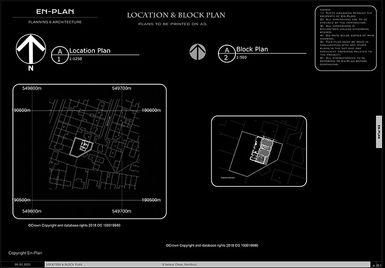
Planning Consultancy:
Planning Enforcement
Planning Enforcement Notices
If you have been served with an Enforcement Notice (EN) by your Local Planning Authority (LPA) you will have the option to appeal against it. However, you will need to carefully consider if you have sufficient grounds for appeal and what the most appropriate course of action should be. One Planning is able to provide professional advice to help you decide on the most appropriate course of action to achieve the best outcome possible. With a background in Local Planing Authority Enforcement Neil Langley from EN-PLAN is ideally placed to help you assess this and guide you through this tricky area.
Reasons for serving an Enforcement Notice
Typically, LPA’s will serve EN’s if you have gone ahead without securing planning permission and the council considers that the development involves a breach of planning control. This will depend on the scale, design and location of the development and its impact on neighbours and the character of the area. In this instance, The LPA will often request that you apply for retrospective planning permission with a formal planning application to make the proposal lawful in planning terms and therefore regularise the development. With our in house full architectural drawing service we can formulate an application that will of address the concerns of the Local Planning Authority and establish a useful dialogue with the Panning Authority on the best way forward; important in a situation where communication has veey often broken down.
Should you appeal?
We would advise that you speak to us before deciding how to proceed. We can offer you a free initial consultation and the benefit of qualified professional planning appraisal. In most cases, we would always try and negotiate with the LPA to achieve an acceptable solution for both parties. However, if this is not possible and we feel that you have sufficient grounds against which to appeal, we are able to prepare and submit a planning enforcement appeal to the Planning Inspectorate on your behalf. The Planning Inspectorate is an executive agency of the Ministry for Communities and Local Government (MCLG).
All Enforcement Appeals must be submitted to the Planning Inspectorate before the date the enforcement notice takes effect. This date will be stated on the Enforcement Notice.
Types of Enforcement Appeal
As with the normal appeal procedure, an Enforcement Appeal can be made in the following ways:
-
Written Representation;
-
Informal Hearing; and
-
Public Inquiry
The most basic and, often quickest, form is via a written representation. This involves both parties submitting written statements. An Informal Hearing allows the appellant & LPA the chance to address the Planning Inspector and is usually held within a Council meeting room. Public Inquiries are more often reserved for larger and more complicated cases where expert witness or professional legal representation is required and permits both parties the chance to cross examine one another. Claims of cost can also be made in all of the above types of appeal should the appellant feel that they have incurred unnecessary expenses in dealing with the proceedings due to the unreasonable behaviour of the LPA. The appeal will be made to The Planning Inspectorate in Bristol.
What does it cost?
If your enforcement appeal is made on the grounds that planning permission should be granted this will include an application for planning permission. This typically costs double the amount paid for a normal planning application. The fee is split between the LPA and DCLG. No fee is payable for the appeal itself.
Withdrawing an Enforcement Appeal
If it has been possible to reach agreement with the LPA, it is possible to withdraw your appeal at any time. SWhat you wikll see in tehb followng case study is how applying for retrospective permission cabn nulify enforcemnt action and give you a positive outcome in the planning system.
En-Plan successfuly fended off enforcement action for a new residential annex in Romford, Essex. We aimed to ensure that the new development is of the highest standards of design which respects, and where possible maintains, enhances or improves the character and appearance of the local area. In particular the form, scale, massing, height of the surrounding neighbouring buildings, public amenity and detailed design. The proposal is for retrospective planning permission for the creation of a granny annexe involving a two storey side and single storey rear extensions.
The proposed single storey rear extension would project 3.00 metres beyond the rear wall of the
original dwelling and cover full width of the rear elevation including the side extension. The development would comprise of a mono-pitched roof. The proposed depth conforms to the 4 metres depth recommendation for semi-detached dwelling in accordance with the Havering's Residential Extensions and Alterations SPD. Furthermore the proposal consists of a shallow pitched roof in compliance with the Council's guidance. The proposed rear extension has been designed to meet the requirements of the Havering's Residential Extensions and Alterations SPD therefore acceptable.
Havering Council considered the resulting extension is capable of independent self-contained accommodation, as such this form of use would be against the pattern of development within the immediate area. The proposal is only judged acceptable on the basis that this is an annexe for members of the family connected to the main dwelling, as this would enable shared use of facilities such as amenity areas and parking and mitigate against over-intensive use of the site. Therefore, it would benecessary to condition to be used as ancillary to the main dwelling and should not be subdivided from the main property at any point in the future.
Overall it is considered that the proposal would not be harmful to the character and appearance of the existing dwellinghouse and the surrounding area. As set out above, Policy DC61 requires that the relationship between existing and proposed development would be harmonious. The neighbouring property to the north has a single storey rear extension. The proposed rear extension has been designed to meet the requirements of the Havering's Residential Extensions and Alterations SPD. The proposed side extension is situated on the opposite side of the host dwelling some distance away from this neighbouring property. Therefore it is considered there is sufficient separation distance that the proposal would have limited impact on residential amenity.
The proposal would be in accordance with National Planning Policies and Havering Planning Policy and is therefore acceptable.
Case Study: The Laurels, Llangollen Road, Acrefair, Wrexham, LL14 3RU
Estyniad unllawr I gefn yr eiddo (rhannol ol-weithredol) / single storey rear extension (partly in retrospect).
En-plan were contatced by the worried owner of the proeprty as a Planning Enforcement Officer from Wrexham Council Planning Department had visited the property and informed the owner of the requirement for retrospective planning approval or enforcement action woud be take against the extension and it would need to be removed.
En-Plan were able to submit a retrospective planning application with quality designs and modelling to show the partially completed extension in its finished version, that allowed Wrexham Council to grant approval and close the enforcement file on the property.
A retrospective planning application in the UK refers to seeking planning permission for a development or change of use that has already taken place without the necessary consent. This is different from a Section 73 application, which aims to vary or remove conditions from an existing planning permission.
The concept of a retrospective planning application isn't linked to a specific "section" like the Section 73 applications. Instead, it's a recognition within the planning system that sometimes developments go ahead without the necessary permissions, either due to an oversight (whihc was the case in this instance), misunderstanding, or deliberate action by the developer or landowner.
If the retrospective application is successful, the development becomes authorized, and any enforcement action related to the lack of permission becomes null and void. However, if the application is refused, the enforcement action can proceed, which may lead to penalties or the requirement to undo the unauthorized works.
Case Study: Appplication Reference 23/00981/F | RETROSPECTIVE APPLICATION: Single storey rear annexe extension, and new cladding to main unit. | Meadowgate Meadowgate Lane Emneth Wisbech Norfolk PE14 0DS.
En-Plan were contatced by the owners who like the above case in Wrexham had been threatend with enforcement action due to them building a residential annex to house an elderley disbaled relative. En-Plan were successful and planning pemrisison was granted by King's Lynn Council.
In the UK, there is provision for planning fee exemptions for developments that aim to benefit disabled persons. Specifically, the planning application fee is exempted for:
-
Development to benefit disabled people: If the sole purpose of the proposed development is to facilitate access, safety, health or comfort for a person with disabilities who lives in or intends to live in the dwelling. This can include, for example:
-
Building ramps or other means of access.
-
Widening doorways or creating new doorways for wheelchair access.
-
Modifying or creating bathrooms to be disability-friendly.
-
-
Change of use: If you're changing the use of a building to provide a means of living for disabled persons. For instance, converting a building into a home or a facility designed specifically for disabled individuals.
To be eligible for the fee exemption:
-
The application must include a statement that the development is solely for the benefit of a disabled person.
-
The local planning authority may request evidence to validate the claim for fee exemption. This evidence could be in the form of medical certification or other relevant documents that support the claim.
It's always a good idea to engage with your local planning authority early on to understand the specific requirements and ensure that the exemption criteria are met. If you have any Planning Enforcemt issues and would like us to give you a free no obligation consultation please contact us and lest discuss how our Planning Consultancy and Architectural Services can assit you.





















